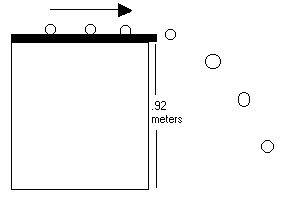WELCOME!!!! You are now in my WEBSITE Ha ha Ha Ha, But on a
lighter note, See my Gauss Rifle .:. Escape 
In the beginning at the semester I was told we would be researching a topic of our choice. I was scared, because I had never researched anything, that I wanted, or chose to.
Over the semester I had thought I would do something simple that I already knew, but could still experiment with, Terminal Velocities (the maximum velocity an object can attain due to outward forces, i.e., friction, air resistance.) But after about two months, the class was learning about magnetism and I changed my project to something about magnetism, but I still wasn’t sure exactly what, I tried solenoids, electro-magnets, and after about a week I was introduced to the gauss rifle, which is a linear, magnetically accelerating momentum transference device.
I logged onto Sci-toys.com and learned how to build my very own gauss rifle and the principles behind it.
The gauss rifle works because of magnetic attraction between the nine steel balls and the four ceramic magnets. The magnets are set at a certain distance between them and with two steel orbs at the left of each one and one steel orb on the right side of the right most when the one orb is released it will accelerate towards the magnet and at the end of the final orb it reaches a final velocity.
![]()

I experimented with changing many variables, such as changing the separations between magnets, changing the mass of the orbs and changing the strength of the magnets. I found that using the larger orbs with a separation between 2 and 3.5 inches would yield a trail that would actually allow the orbs to break the magnetic field and off the accelerator.
|
2 inch
separation |
|
3 inch
separation |
|
2 inch
separation W/ |
|||
|
with
large orbs |
|
with
large orbs |
|
8 large
orbs and 1 small |
|||
|
trial |
distance(m) |
trial |
distance(m) |
trial |
distance(m) |
||
|
1 |
0.36 |
|
1 |
0.29 |
|
1 |
0.55 |
|
2 |
0.37 |
|
2 |
0.28 |
|
2 |
0.46 |
|
3 |
0.38 |
|
3 |
0.29 |
|
3 |
0.48 |
|
4 |
0.38 |
|
4 |
0.28 |
|
4 |
0.44 |
|
5 |
0.39 |
|
5 |
0.28 |
|
5 |
0.46 |
|
avg |
0.36 |
|
avg |
0.28 |
|
avg |
0.48 |
|
Velocity |
1.73 m/s |
|
Velocity |
1.28 m/s |
|
Velocity |
2.18 m/s |
|
acceleration |
3.93
m/s/s |
acceleration |
2.91
m/s/s |
acceleration |
4.95
m/s/s |
||
I thought that I would collect 15 data points, but after 5 trails on the three experiments that actually fired, the last orb fell on the same point with an uncertainty of about .001m, so I took the 5 points and averaged data.

I got the data in a 2-D setup where I found the final velocity by using S.U.V.A.T. using a .92 m counter top and measuring the horizontal displacement.
I collected all my data and averages, I used S.U.V.A.T to find the horizontal acceleration using applications of scientific fundamentals the trails with the 2” separation between magnets and a smaller mass ball at the end I got the farthest and fasters trails of all the experiments.
For related websites, whether it be for fun or the ultimate pursuit of knowledge, you should click on these links!!!!!!!!!!!!!!!!!!!!!!!!!!!
To learn how to build your very own magnetic accelerator, go to scitoys.com
if you want to see another high school students setup of this wonderful experiment click here
To Learn more about the wonderful world of Charged Particles Click HERE